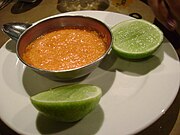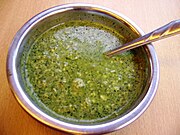Ají (sauce)
 Salsa de ají verde (green salsa de ají) in a market in the city of Huaraz, Peru. | |
| Type | Condiment/sauce |
|---|---|
| Place of origin | Andes |
| Region or state | Latin America |
| Main ingredients | Ají peppers |
| Ingredients generally used | Water, oil, garlic, cilantro, salt |
| Variations | Ají chileno, ají negro, ají amarillo, ajílimojili, ají rocoto |
Ají is a spicy sauce that contains ají peppers, oil, tomatoes, cilantro (coriander), garlic, onions, and water. It is served as a condiment to complement main dishes, most oftentimes in Latin American cuisines, and prepared by blending its ingredients using a food processor or blender. Although ají sauce recipes can vary from person to person, there are generally country-specific and region-specific varieties.
Description[edit]
Ají is a spicy sauce made from ají peppers that is usually served to accompany other dishes in a variety of Latin American cuisines.[1] Its most basic ingredients include ají peppers, water, oil, garlic, cilantro, and salt.[2][3] Ingredients are usually blended together using a blender or food processor.[4]
Ají has been prepared in Andean countries such as Bolivia, Colombia, and Peru since at least the time of the Incas, who called it uchu.[5][6] It is usually added to other foods such as anticuchos, chugchucaras, soup, chorizo, or empanadas.[7][8][9]
In Colombia and Ecuador, food is traditionally milder, so ají can be added to almost any dish to add flavor and spice.[10] Recipes vary dramatically from person to person and from region to region, depending on preference.[11]
The core ingredient of ají sauce, ají peppers (Capsicum baccatum), was originally grown in South America.[12] While these peppers have a Scoville Heat Unit of 30,000 - 50,000, depending on the variety of pepper and preparation technique, the spice level of ají sauce is variable.[12]
Varieties[edit]
Chile[edit]
In Chile there is a popular hot sauce known as ají chileno that uses the peppers.[13] Chileans also make a salsa called pebre using the peppers combined with tomatoes, cilantro, onions, oil, and vinegar which is typically eaten with bread.[14]
Ecuador[edit]
In Ecuador, ají sauce is prepared using one of the over 30 ají pepper varieties available in the country.[4] These ají peppers vary in spice level and this, combined with the amount of water used to dilute the sauce, can create variation in the level of spice between sauces.[4] Some regions are also known for their addition of fruits, in addition to the basic ingredients, which leads to further variety of the sauce within the country.[4]
North West Amazonia[edit]
A variety of ají sauce called ají negro (also called Ommaï, Kígai, Do-Hmepa, Ualako) is made by the indigenous peoples of the North West Amazonia.[15] This variety is prepared using the juice of bitter manioc.[15]
Peru[edit]
Peru is known for a variety of ají sauce called ají amarillo sauce.[16] This variety uses ají amarillo and is notable for its yellow color. Ají amarillo is used widely across Peru as an addition to sauces.[16] The spice level of ají amarillo is comparable to serrano peppers registering at 15,000 on Scoville Heat Unit Scale, although sometimes registering at 30,000 to 50,000 SHU.[16][4] Oftentimes this variety of ají sauce is mixed with mayonnaise, crema, or sour cream to accompany potatoes, sandwiches, meat, and ceviche.[16][2]
Puerto Rico[edit]
Puerto Rico has a variety of ají sauce called ajilimojili.[17] This variety uses aji dulce peppers and is notable for its green color.[17]
United States[edit]
In the United States, several pre-prepared varieties of ají sauce, including aji rocoto hot sauce and aji amarillo sauce, can be purchased in Latin American markets or specialty food stores.[1][18] The pepper required for some varieties of ají sauce, including that of the Peruvian ají amarillo sauce, is not grown commercially in the United States.[4]
Gallery[edit]
-
Salsa de ají and key lime from Peru
-
Ají charapita
-
Crema de ají
See also[edit]
References[edit]
- ^ a b Mautone, Gianna. "A Vegan Taste of ECUADOR." Vegetarian Journal, vol. 32, no. 3, 2013, pp. 6-8. ProQuest.
- ^ a b Erin (August 26, 2022). "Easy Aji Amarillo Sauce". Platings + Pairings. Retrieved April 3, 2023.
- ^ "Peruvian Quinoa Shrimp Chicharrones with Green Aji Sauce". Oldways. Retrieved April 3, 2023.
- ^ a b c d e f "Adventures in cooking with the rare aji amarillo". The Takeout. October 22, 2020. Retrieved April 24, 2023.
- ^ "Culinary History of Peru". Cultural Expeditions, Inc. Archived from the original on May 9, 2008. Retrieved July 21, 2008.
- ^ Villacorta, Manuel; Shaw, Jamie (2013). Peruvian Power Foods: 18 Superfoods, 101 Recipes, and Anti-aging Secrets from the Amazon to the Andes. Deerfield Beach, FL: Health Communications, Inc. pp. 98–103. ISBN 978-0-7573-1722-4.
- ^ Matsuhisa, Nobuyuki (2001). Nobu: The Cookbook. Tokyo: Kodansha International. p. 79. ISBN 978-4-7700-2533-3.
- ^ McCausland-Gallo, Patricia (2004) [2001]. Secrets of Colombian Cooking. New York: Hippocrene Books. p. 158. ISBN 978-0-7818-1025-8.
- ^ Kijac, Maria Baez (2003). The South American Table: The Flavor and Soul of Authentic Home Cooking from Patagonia to Rio de Janeiro, with 450 Recipes. Boston, MA: Harvard Common Press. p. 263. ISBN 978-1-55832-249-3.
- ^ Hippo!, Orange (May 16, 2023). The Little Book of Hot Sauce: A passionate salute to the world's fiery condiment. Welbeck Publishing Group. ISBN 978-1-83861-148-4.
- ^ Perlman, Dan (October 3, 2016). Eat Salt. ISBN 978-1-365-43500-3.
- ^ a b IFOTC (December 12, 2019). "Eat Ecuador - The Sauce on Every Table in Ecuador - AJI SAUCE". Itchy Feet on the Cheap. Retrieved April 24, 2023.
- ^ "Ají Chileno JB". ChinChile. Retrieved February 4, 2024.
- ^ Redmond, Kari (April 20, 2023). "5 Foods You Need To Try In Chile To Eat Like A Local — Plus Where To Find Them". TravelAwaits. Retrieved February 4, 2024.
- ^ a b "Ají negro - Arca del Gusto". Fondazione Slow Food (in Italian). Retrieved April 3, 2023.
- ^ a b c d Peru, Kosmos. "Aji Amarillo sauce the delight of Peru". Kosmos Peru. Retrieved April 3, 2023.
- ^ a b "Celebrate Traditional Puerto Rican Fare." Tampa Bay Times, Jul 31, 2019, pp. 3. ProQuest.
- ^ "New Dressing, Sauces & Spreads." Prepared Foods, 2019. ProQuest.





